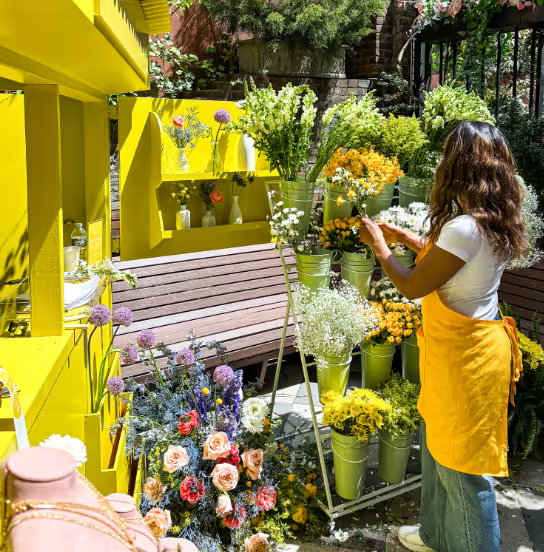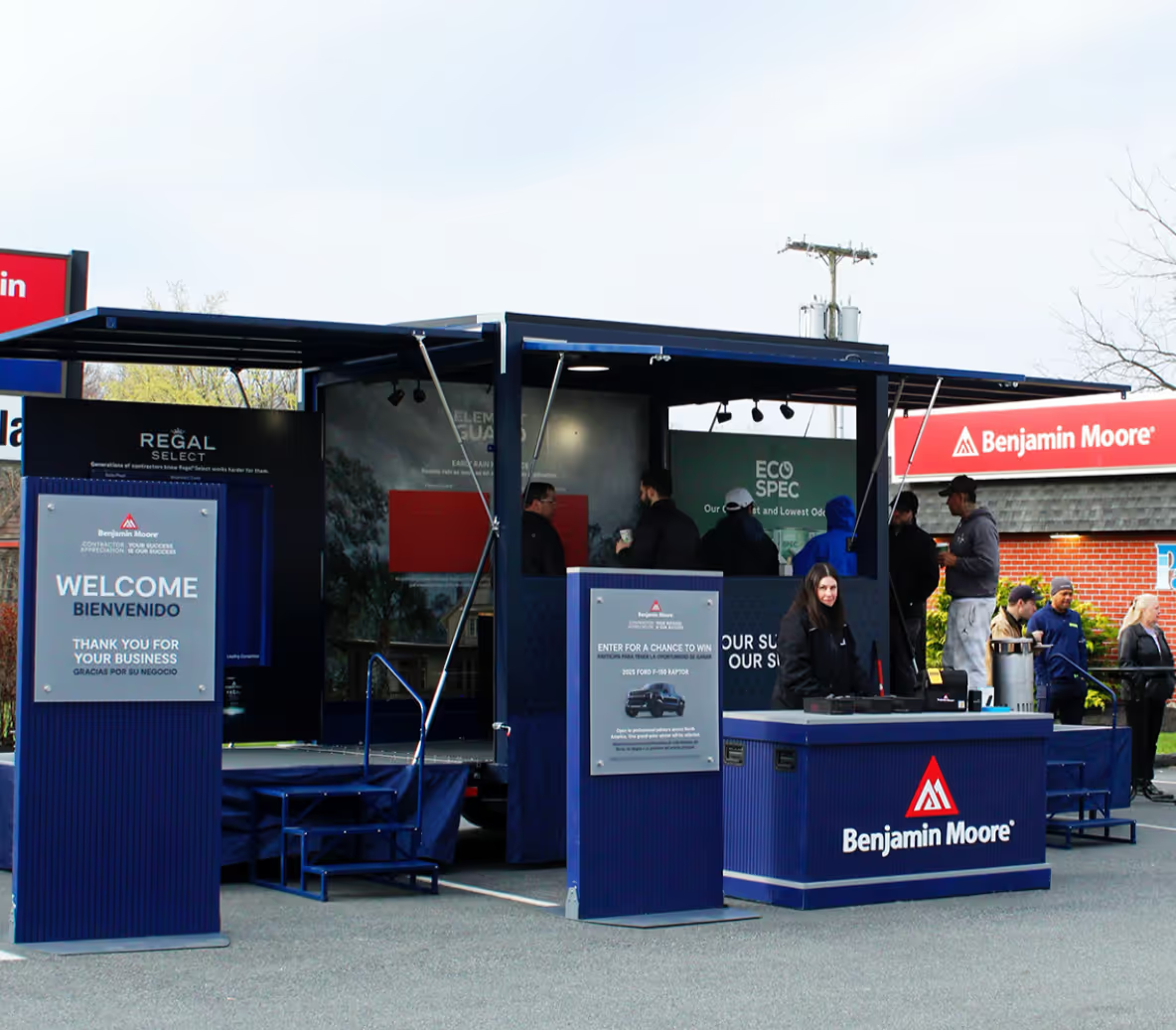Press Activation Events: Beyond Traditional Media Relations
Press activation events create environments where journalists engage directly with brand stories through hands-on experiences, product demonstrations, and exclusive access opportunities. These events give media professionals the content and interactions they need to create compelling coverage across traditional outlets, digital platforms, and social media channels.
Rather than delivering information through standard announcements, press activation events invite journalists to participate in brand experiences that generate authentic stories and lasting professional relationships. When designed with clear objectives and measurable outcomes, these events produce coverage to drive ROI while building the media connections brands need for sustained visibility and growth.
When brands need to reach media professionals across multiple markets, brand activation roadshows deliver consistent messaging while adapting to local media preferences and coverage needs.
How Media Consumption Shapes Brand Activation Strategies
Media consumption patterns influence how brands design press activation events to generate coverage and audience engagement. Journalists now create content for multiple platforms simultaneously, requiring events that support diverse content creation needs from photography and video production to real-time social media posting. Press activation events must provide the resources, access, and experiences that enable media professionals to create the content their audiences expect across different channels and formats.
Product Demonstrations and Hands-On Media Experiences
Product demonstrations provide journalists with concrete stories they can share with their audiences through direct interaction and testing. Press activation events that feature live product demonstrations, customization stations, or sampling opportunities give media professionals firsthand experience with brand offerings. These interactions create authentic coverage opportunities because journalists can speak from personal experience rather than relying on prepared statements or promotional materials.
Media professionals attend press activation events expecting access to products, services, or experiences they cannot get elsewhere. This might include early access to new product launches, exclusive customization options, or behind-the-scenes access to brand operations. The hands-on element gives journalists substantive content that supports in-depth coverage and provides their audiences with valuable insights about brand offerings.
Event Marketing Design for Media Documentation
Press activation events require physical environments that support the content creation needs of attending journalists and media professionals. These events must provide the visual elements, technical support, and interactive opportunities that enable media coverage across different formats and platforms:
- Branded Photo Setups: Custom backdrops and product displays that give journalists professional-quality visuals for their coverage
- Interview Spaces: Quiet areas with proper lighting where journalists can conduct interviews with brand representatives or industry experts
- Product Interaction Areas: Hands-on stations where media professionals can test, customize, or experience brand offerings firsthand
- Technical Support: On-site assistance for lighting, audio, and equipment needs that help journalists create quality content during the event
- Documentation Resources: Press kits, high-resolution images, and product information that journalists can use to supplement their coverage
Journalists remember events that give them exclusive access and compelling stories they can't find anywhere else, making business brand activations powerful tools for building lasting media relationships during corporate events.
Immediate Story Creation and Media Resources
Press activation events must provide journalists with the resources and access they need to create stories during the event itself. Media professionals expect immediate access to executives, product demonstrations, and supporting materials that enable them to file coverage while the event is happening. These events succeed when they eliminate barriers to story creation by providing press kits, professional imagery, and interview opportunities that support real-time reporting.
Journalists attending press activation events need comprehensive resources that support their coverage requirements. This includes access to brand representatives who can provide quotes and insights, product demonstrations that illustrate key messages, and professional photography that enhances their stories. The event marketing environment should facilitate immediate content creation so journalists can meet publication deadlines while the event generates maximum news value.
Brand Activation Ideas for Press Events
Press activation events work when they give journalists stories worth telling and experiences worth documenting. Successful brand activation ideas move beyond standard announcements to create environments where media professionals can gather content, conduct interviews, and witness brand interactions firsthand.
Product Launch Experiences
Product launch activations allow journalists to interact with new offerings while documenting the launch process. The Coach Tabby Tour brought product demonstrations directly to college campuses through custom shipping containers with dimensional displays, interactive elements, and coordinated giveaways that created photo opportunities and hands-on experiences for media coverage.
- Oversized Product Displays: Large-scale installations that showcase products while serving as photo backdrops for media documentation
- Customization Workshops: Live personalization stations where journalists can watch products being made and interview participants
- Executive Access Sessions: Scheduled interview opportunities with company leadership in dedicated spaces for professional coverage
- Product Sample Programs: Samples and merchandise that journalists can test and feature in their stories

Multi-Sensory Brand Installations
Multi-sensory installations create story environments through activities that engage sight, sound, touch, taste, and smell. The Kendra Scott Mother's Day activation featured floral framing workshops, conversation card activities, jewelry customization stations, and fresh bouquet creation that gave journalists multiple content angles and interview subjects.

Mobile Brand Experiences
Mobile experiences bring brand stories to journalists in their local markets through custom vehicles and portable installations. The Benjamin Moore Contractor Appreciation Tour utilized custom trailer showrooms with product demonstrations, interactive displays, and local market activations that provided journalists with regional story opportunities while maintaining consistent brand messaging across different locations.
- Mobile Showrooms: Trailers with product displays, demonstration areas, and interview spaces for professional coverage
- Community Integration Events: Local partnerships and market programming that provide journalists with regional story angles
- Product Testing Stations: Interactive areas where journalists can experience products and document reactions
- Market Customization: Regional elements and local partnerships that create location-specific story opportunities

Media Package Development for Press Events
Press materials for activation events include multimedia components that give journalists the resources they need to create comprehensive coverage. These packages combine written content, professional photography, video assets, and background information that supports the stories journalists will write about the event. Media packages should provide journalists with ready-to-use content that enhances their coverage while driving attendance and engagement at press activation events through compelling preview materials and exclusive access opportunities.
Interactive and Multimedia Press Release Formats
Press packages for activation events combine multiple content formats that give journalists comprehensive resources for their coverage. These packages include video content, professional photography, and interactive elements that enhance story quality while providing journalists with ready-to-use assets:
- Video Assets: Product demonstrations, executive interviews, and behind-the-scenes footage that journalists can embed in their coverage
- Professional Photography: High-resolution images of products, event spaces, and brand representatives that support visual storytelling
- Interactive Elements: Downloadable resources, press kit materials, and digital assets that journalists can access during and after the event
- Background Materials: Company information, industry data, and expert insights that provide context for journalist coverage
- Preview Content: Exclusive glimpses of event experiences that generate media interest and drive attendance
Media Distribution and Outreach Coordination
Press activation events require coordinated media distribution that reaches journalists across multiple channels and platforms to maximize coverage potential. Distribution strategies must align with event timing to generate momentum that drives both attendance and media coverage:
- Direct Journalist Outreach: Personalized invitations and press materials sent to beat reporters and relevant media contacts
- Industry Publications: Targeted distribution to trade publications and specialized outlets that cover specific sectors
- Wire Services: Broad distribution through traditional press release services that reach general media outlets
- Social Media Amplification: Strategic posting that generates interest in the event while reaching journalists who follow brand accounts
- Timing Coordination: Distribution schedules that provide journalists with adequate lead time while maintaining news value and event momentum
Developing Long-Term Media Professional Relationships
Press activation events create opportunities to build lasting relationships with journalists and media professionals through direct interaction and valuable experiences. These relationships develop through consistent communication, exclusive access opportunities, and face-to-face meetings that establish trust and mutual understanding. Strong media relationships result in better coverage, increased event attendance, and ongoing collaboration that benefits both brands and journalists who cover relevant industries and topics.
Social Media Communication with Media Professionals
Social media platforms provide direct communication channels between brands and journalists that support relationship building beyond press activation events. These platforms enable brands to share industry insights, company updates, and behind-the-scenes content that keeps media professionals engaged between formal press interactions:
- Industry Commentary: Sharing relevant news analysis and expert perspectives that demonstrate thought leadership and industry knowledge
- Behind-the-Scenes Content: Exclusive glimpses of company operations, product development, or team activities that provide story opportunities
- Professional Conversations: Engaging with journalist posts, commenting on industry developments, and participating in relevant discussions
- Resource Sharing: Providing access to industry data, research findings, or expert contacts that support journalist coverage needs
- Event Updates: Sharing preview content, preparation activities, and exclusive details that generate interest in upcoming press activation events
Ongoing Communication and Media Relationship Maintenance
Long-term media relationships require consistent communication that maintains journalist interest between press activation events through regular updates, industry insights, and exclusive access opportunities. This ongoing engagement creates the foundation for brand advocacy that results in favorable coverage and increased event attendance:
- Regular Updates: Sharing company developments, product launches, and industry news that provides journalists with ongoing story opportunities
- Exclusive Access: Providing early information, executive interviews, and behind-the-scenes access that gives journalists competitive advantages
- Industry Insights: Offering expert analysis, market data, and trend observations that support journalist coverage across different topics
- Resource Support: Connecting journalists with subject matter experts, providing research assistance, and offering additional sources for their stories
- Relationship Investment: Maintaining personal connections through regular check-ins, meeting scheduling, and professional development support
Create Press Activation Events with Activate
Activate produces press activation events that generate media coverage and build journalist relationships through hands-on experiences and exclusive access opportunities. We handle concept development, custom fabrication, logistics coordination, and on-site execution from our 75,000 square foot Metro Detroit facility. Our team designs events that give journalists compelling stories while delivering measurable business results for global brands. Visit our contact form to discuss your press activation event needs.
Frequently Asked Questions
What are activation events?
Activation events are immersive brand experiences that engage audiences through hands-on interactions, product demonstrations, and multi-sensory environments designed to create lasting connections between brands and their target demographics. These events include live activations, mobile tours, pop-up experiences, and custom installations that boost engagement, social media coverage, and business outcomes for participating brands.
How to plan an activation event?
Planning an activation event requires establishing clear objectives, identifying target audiences, and designing experiences that align with brand messaging while providing memorable interactions for attendees. The planning process involves concept development, venue selection, custom fabrication, logistics coordination, staffing management, and performance measurement to ensure successful execution and measurable results.
